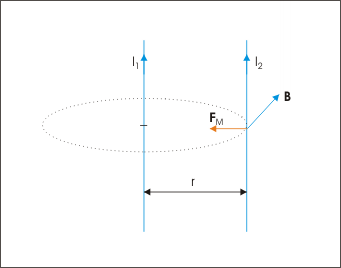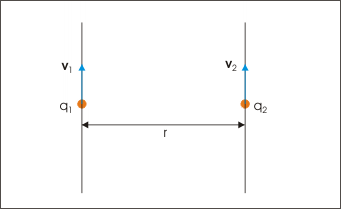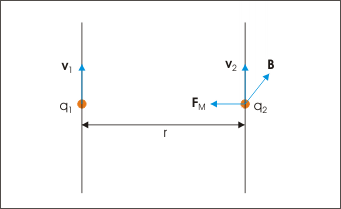| << Chapter < Page | Chapter >> Page > |
In the case of two parallel wires, one of the wires works as the producer of magnetic field whereas the other wire is considered to experience the magnetic force due to magnetic field produced by the first wire. This role is completely exchangeable. It only depends on what we want to observe. If we want to observe the magnetic force on the first wire, then the second wire works as the producer of magnetic field and vice-versa.
Let us consider here two long straight wires carrying currents and in the same direction. It is important to note here that one of two wires is a long straight wire. It ensures that magnetic field due to one of them is same at equal perpendicular distance. Otherwise, it would be difficult to determine magnetic force as they will be different at different points of the other wire. According to Ampere's law , the magnetic field due to first long wire at a perpendicular distance “r” is :
Magnetic force between two parallel wires carrying current

Applying Right hand thumb rule, we see that magnetic field is perpendicular and into the plane of drawing. Thus, angle between length and magnetic field vector is right angle. The magnetic force on the second wire is:
The direction of magnetic force is obtained again by applying Right hand thumb rule. We curl fingers of right hand such that it follows the curve as we move from the length vector to the magnetic field vector. The extended thumb, then, points in the direction of magnetic force. In this case, magnetic force acts towards right as shown in the figure. The magnetic force on unit length of second wire is obtained by putting L=1 m,
Substituting for B, we have :
The above expression gives the magnetic force on second wire due to first wire. We should here understand that second wire also applies equal and opposite force on the first wire in accordance with Newton’s third law. Thus, two parallel wires carrying current in the same direction attract each other. If the currents are in the opposite directions, then two wires repel each other.
If one of two wires is a finite wire of length “L”, then magnetic force on either of the parallel wires is given by multiplying the force per unit length with the length of finite wire,
The SI unit of current i.e. Ampere is defined in terms of magnetic force between two parallel wires carrying current. Significantly, this unit is not defined in terms of charge per unit time as measuring the same is difficult.
Putting, , the magnetic force per unit length is :
Thus, one Ampere is that constant current which, if maintained in two straight parallel conductors of infinite length, of negligible circular cross-section, and placed 1 m apart in vacuum, would produce between these conductors a force equal to Newton per meter of length.
Problem : Two horizontal copper wires are parallel to each other in a vertical plane with a separation of 0.5 cm. The wires carry equal magnitude of current such that the lower wire becomes weightless. The mass per unit length of wires is 0.05 kg/m. Determine the currents in the wire and their relative directions.
Solution : The lower wire has its weight due to its mass and gravity. If it becomes weightless on passage of currents in the wire, then it means that the lower wire is attracted by the upper wire. Clearly, currents in two parallel wires are flowing in the same direction. Now, magnetic force per unit length on the wire should be equal to weight of the wire per unit length.
Where “F” is magnetic force per unit length and “m” is mass per unit length. Putting expression of magnetic field in the equation, we have :
Since , we have:
Putting values,
Let two charge carrying particles are at a linear distance “r” at a given instant. The initial state of motions of two charges is shown in the figure.
Magnetic force between two charges moving parallel to each other

The magnetic field at the position of second charge due to first charge is given by Biot-Savart law as expressed for moving charge is:
Magnetic force between two charges moving parallel to each other

The direction of magnetic field is “ v X r ”, which is into the plane of drawing. Now, magnetic force on the charge is given by Lorentz force law as :
Substituting for magnetic field, we have :

Notification Switch
Would you like to follow the 'Electricity and magnetism' conversation and receive update notifications?